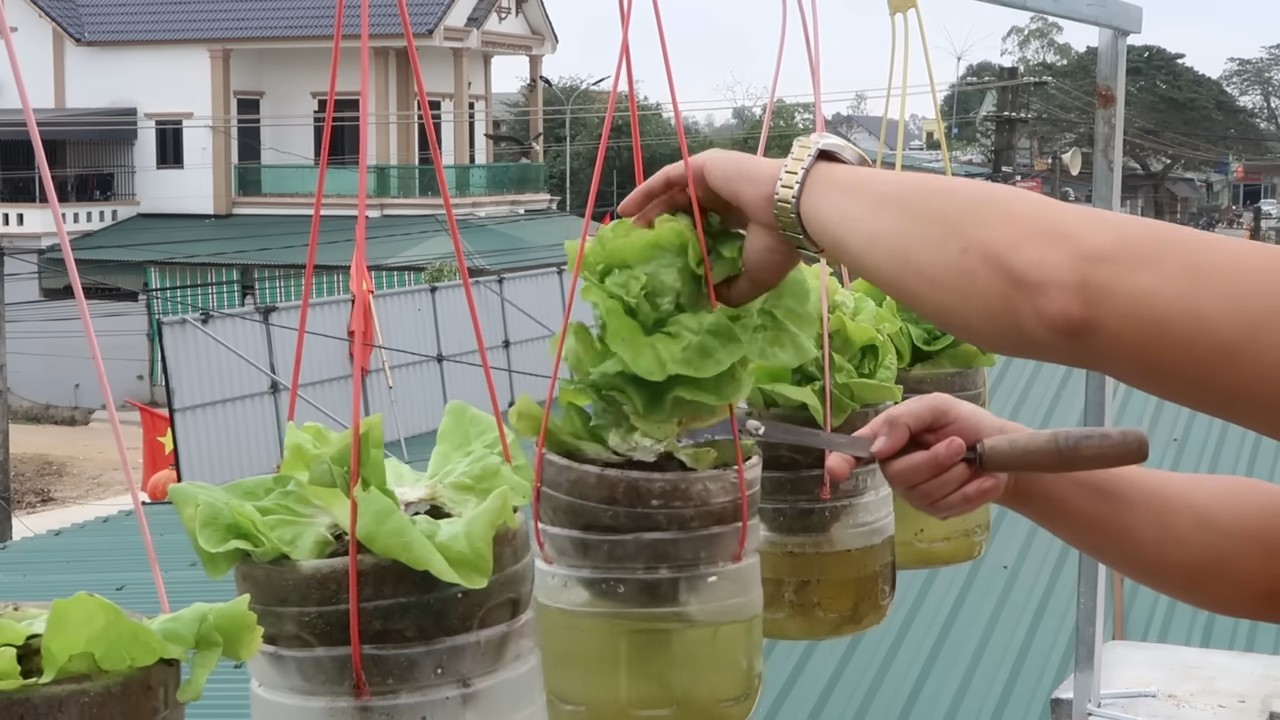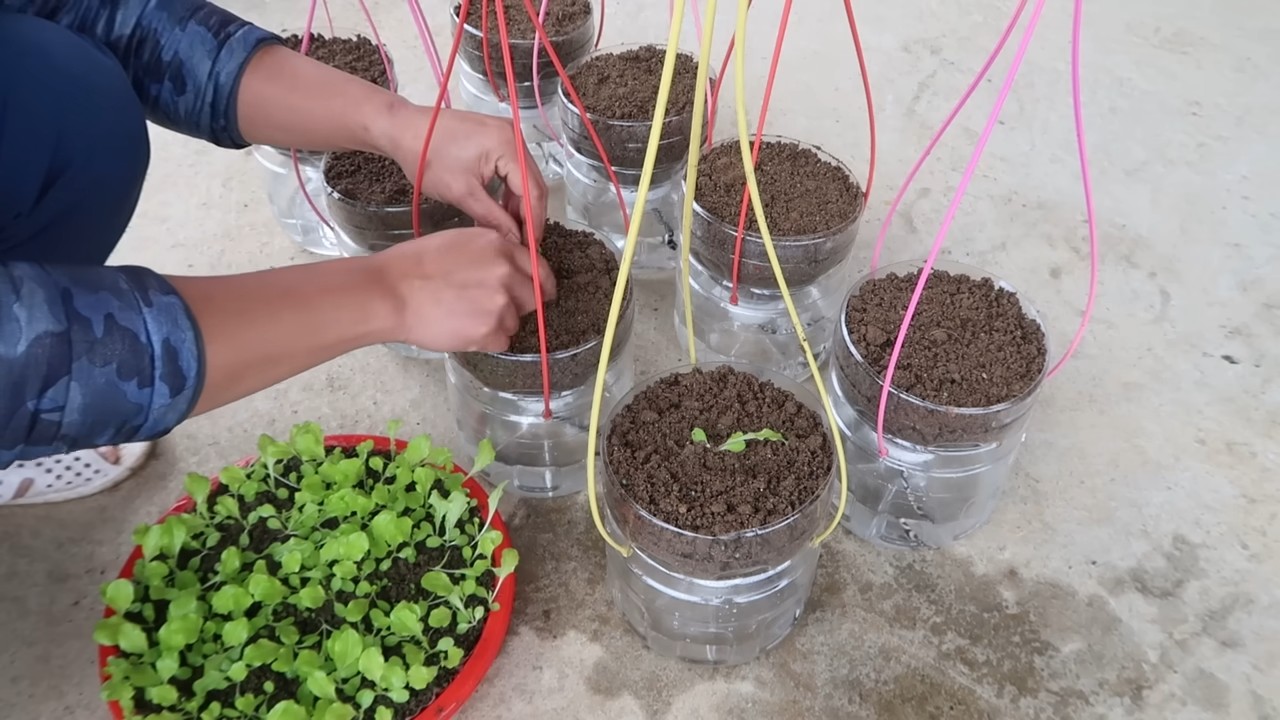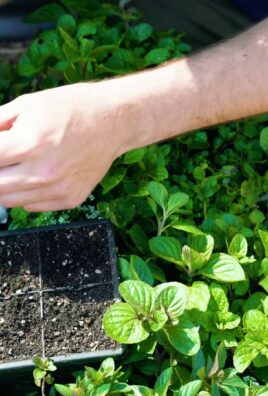Hanging lettuce soil free? Sounds like something out of a sci-fi movie, right? But trust me, it’s not only possible, it’s incredibly rewarding! Imagine fresh, crisp lettuce dangling right outside your kitchen window, ready to be snipped and tossed into your salad whenever you please. No more trips to the grocery store for limp, overpriced greens!
The concept of growing plants without soil, known as hydroponics, has been around for centuries. From the legendary Hanging Gardens of Babylon to ancient Aztec agricultural practices, humans have long sought innovative ways to cultivate food. While our modern methods are a bit more streamlined, the underlying principle remains the same: providing plants with the nutrients they need without the mess and limitations of traditional soil gardening.
In today’s busy world, who has time to spend hours weeding and watering a traditional garden? That’s where this DIY trick comes in. Hanging lettuce soil free is a game-changer for apartment dwellers, busy professionals, and anyone looking to maximize their space and minimize their gardening effort. It’s a fun, sustainable, and surprisingly easy way to enjoy fresh, homegrown lettuce all year round. I’m excited to share my step-by-step guide to creating your own hanging lettuce garden, so let’s get started!

DIY Hanging Lettuce Garden: Soil-Free & Space-Saving!
Hey there, fellow gardening enthusiasts! Are you short on space but dreaming of fresh, homegrown lettuce? Well, I’ve got the perfect solution for you: a DIY hanging lettuce garden that’s completely soil-free! This project is not only incredibly easy and affordable, but it’s also a fantastic way to add a touch of greenery to your balcony, patio, or even indoors. Plus, no soil means less mess and fewer pests! Let’s dive in and get our hands dirty (well, not really, since it’s soil-free!).
What You’ll Need:
Before we get started, let’s gather all the necessary materials. Don’t worry, most of these are readily available at your local hardware or garden store.
* **Plastic Bottles:** You’ll need several plastic bottles, preferably 2-liter soda bottles or similar. The number of bottles depends on how big you want your hanging garden to be. I recommend starting with at least 6.
* **Scissors or Utility Knife:** For cutting the plastic bottles. Be careful!
* **Drill or Awl:** To create drainage and hanging holes.
* **Rope or Strong Twine:** To hang the bottles. Choose something durable that can withstand the weight of the lettuce and water.
* **Net Pots or Small Plastic Cups:** These will hold the lettuce seedlings. The size should fit comfortably inside the bottle openings.
* **Hydroponic Growing Medium:** This is the key to our soil-free garden! I recommend using coco coir, perlite, or a mix of both. These materials provide excellent drainage and aeration for the roots.
* **Lettuce Seedlings:** You can start your own from seeds or buy them from a nursery. Choose your favorite varieties! I personally love Romaine, Butterhead, and Red Leaf lettuce.
* **Hydroponic Nutrient Solution:** This provides the essential nutrients that the lettuce needs to grow. You can find pre-mixed solutions at most garden centers.
* **Water:** For mixing the nutrient solution and watering the plants.
* **Measuring Cup or Pitcher:** To accurately measure the nutrient solution.
* **Gloves (Optional):** To protect your hands.
Preparing the Bottles:
This is where we transform those ordinary plastic bottles into mini lettuce planters!
1. **Clean the Bottles:** Thoroughly wash the plastic bottles with soap and water to remove any residue. Rinse them well and let them dry completely. This is important to prevent any contamination that could harm your lettuce.
2. **Cut the Bottles:** Using your scissors or utility knife, carefully cut each bottle in half horizontally. You’ll be using the top half of the bottle as the planter. Discard or recycle the bottom half. I usually cut mine about 2/3 of the way up, leaving a slightly longer top portion.
3. Create Drainage Holes: Using your drill or awl, create several small drainage holes in the bottom of the top half of each bottle. These holes are crucial for preventing waterlogging and ensuring proper aeration for the roots. I usually make about 4-5 holes, spaced evenly apart.
4. **Create Hanging Holes:** Now, drill or punch two holes on opposite sides of the bottle, near the top edge. These holes will be used to thread the rope or twine for hanging. Make sure the holes are large enough to accommodate your chosen rope or twine. I like to reinforce the holes with a small piece of duct tape to prevent tearing.
Planting the Lettuce:
Time to get those lettuce seedlings into their new soil-free homes!
1. **Prepare the Growing Medium:** Moisten your chosen hydroponic growing medium (coco coir, perlite, or a mix) with water. It should be damp but not soaking wet. I usually soak the coco coir in a bucket of water for about 30 minutes, then squeeze out the excess water.
2. **Fill the Net Pots:** Fill each net pot or small plastic cup with the moistened growing medium. Leave a little space at the top.
3. **Plant the Seedlings:** Gently remove the lettuce seedlings from their original containers. Carefully loosen the roots and place each seedling in a net pot filled with the growing medium. Gently press the growing medium around the roots to secure the seedling.
4. **Place the Net Pots in the Bottles:** Place each net pot containing a lettuce seedling into the top half of a prepared plastic bottle. The net pot should sit snugly in the bottle opening.
Creating the Hanging System:
Let’s assemble our hanging lettuce garden!
1. **Cut the Rope or Twine:** Cut several lengths of rope or twine, depending on how long you want your hanging strands to be. Remember to leave enough extra length for tying knots and adjusting the height. I usually cut mine about 3-4 feet long.
2. **Thread the Rope:** Thread one end of a rope length through the hanging holes in one of the bottles. Tie a secure knot to hold the bottle in place. Repeat this process for all the bottles.
3. **Connect the Bottles:** Now, connect the bottles together to create a hanging chain. You can do this by tying the bottom of one rope length to the top of another. Experiment with different arrangements to create the look you want. I like to stagger the bottles at different heights for a more visually appealing effect.
4. **Hang the Garden:** Find a suitable location to hang your lettuce garden. Make sure it receives plenty of sunlight (at least 6 hours per day) and is protected from strong winds. You can hang it from a balcony railing, a patio overhang, or even indoors near a sunny window. Use a sturdy hook or bracket to support the weight of the garden.
Watering and Feeding:
Proper watering and feeding are essential for healthy lettuce growth.
1. **Prepare the Nutrient Solution:** Follow the instructions on your hydroponic nutrient solution to prepare the correct concentration. Use a measuring cup or pitcher to ensure accuracy. I usually mix a fresh batch of nutrient solution every week.
2. **Water the Plants:** Water the lettuce plants regularly with the nutrient solution. The frequency of watering will depend on the weather and the type of growing medium you’re using. Check the moisture level of the growing medium regularly. It should be damp but not soggy. I usually water mine every 2-3 days, or when the top inch of the growing medium feels dry.
3. **Monitor the Plants:** Keep a close eye on your lettuce plants for any signs of pests or diseases. If you notice any problems, address them promptly. I like to inspect my plants every day for aphids, slugs, or other common garden pests.
4. **Flush the System:** Every few weeks, flush the system with plain water to remove any accumulated salts or minerals. This will help to prevent nutrient imbalances and keep the plants healthy. I usually flush mine every 2-3 weeks.
Harvesting Your Lettuce:
The best part of all – enjoying your fresh, homegrown lettuce!
1. **Harvesting:** You can start harvesting your lettuce leaves as soon as they are large enough to eat. Simply snip off the outer leaves with scissors or a knife. The plant will continue to produce new leaves, so you can harvest continuously throughout the growing season. I usually harvest mine a few leaves at a time, as needed.
2. **Enjoy!** Wash the harvested lettuce leaves thoroughly and enjoy them in salads, sandwiches, or wraps. There’s nothing quite like the taste of fresh, homegrown lettuce!
Troubleshooting Tips:
Even with the best planning, you might encounter a few challenges along the way. Here are some common issues and how to address them:
* **Yellowing Leaves:** This could be a sign of nutrient deficiency. Make sure you’re using the correct concentration of nutrient solution and that you’re watering the plants regularly.
* **Slow Growth:** This could be due to insufficient sunlight. Make sure your lettuce garden is located in a sunny spot.
* **Pests:** Aphids, slugs, and other pests can attack lettuce plants. Inspect your plants regularly and take action to control pests as needed. I like to use organic pest control methods, such as neem oil or insecticidal soap.
* **Root Rot:** This can occur if the growing medium is too wet. Make sure you have adequate drainage holes in the bottles and that you’re not overwatering the plants.
Extra Tips and Tricks:
* Choose the Right Lettuce Varieties: Some lettuce varieties are better suited for hanging gardens than others. Look for compact varieties that don’t get too large.
* Start with Seedlings: Starting with seedlings is generally easier than starting from seeds, especially for beginners.
* Rotate the Plants: Rotate the bottles regularly to ensure that all sides of the plants receive equal sunlight.
* Add Support: If your lettuce plants start to get too heavy, you can add some extra support to the bottles with twine or wire.
* Get Creative! Don’t be afraid to experiment with different bottle arrangements and hanging systems. You can create a truly unique and personalized lettuce garden.
And there you have it! A complete guide to creating your own soil-free hanging lettuce garden. I hope you found

Conclusion
So, there you have it! Hanging lettuce soil free isn’t just a quirky gardening trend; it’s a genuinely effective and rewarding way to grow fresh, delicious greens right at home, even if you’re short on space or dealing with challenging soil conditions. We’ve explored the simplicity of the method, the benefits it offers, and the straightforward steps to get you started.
But why is this DIY trick a must-try? Beyond the sheer novelty of a hanging lettuce garden, consider the practical advantages. You’re reclaiming vertical space, making it ideal for balconies, patios, or even indoor setups with sufficient light. You’re minimizing soilborne pests and diseases, leading to healthier, more vibrant lettuce. And you’re creating a visually appealing and conversation-starting feature that adds a touch of green to your living space.
The beauty of this method lies in its adaptability. Feel free to experiment with different types of lettuce. Romaine, butterhead, and loose-leaf varieties all thrive in hanging systems. You can also incorporate other leafy greens like spinach or kale for a diverse and nutritious harvest. Consider adding companion plants like marigolds or basil to deter pests naturally.
Don’t be afraid to get creative with your containers. While we’ve focused on repurposing plastic bottles, you can use hanging baskets, fabric grow bags, or even repurposed buckets. Just ensure your chosen container has adequate drainage to prevent waterlogging.
Remember to adjust your watering schedule based on the weather and the specific needs of your lettuce varieties. Check the moisture level of the growing medium regularly and water when the top inch feels dry. A balanced liquid fertilizer, diluted according to the manufacturer’s instructions, can provide essential nutrients for optimal growth.
We understand that venturing into a new gardening technique can be a little daunting. But trust us, hanging lettuce soil free is surprisingly easy and incredibly satisfying. The reward of harvesting your own fresh, organic lettuce, grown with your own hands, is well worth the effort.
So, what are you waiting for? Gather your materials, follow our simple steps, and embark on your own hanging lettuce adventure. We’re confident that you’ll be amazed by the results.
And most importantly, we want to hear about your experience! Share your photos, tips, and challenges in the comments below. Let’s create a community of hanging lettuce enthusiasts and learn from each other’s successes. Your insights could inspire others to try this fantastic DIY trick and discover the joy of growing their own food. Happy gardening!
Frequently Asked Questions (FAQ)
What type of lettuce grows best in a hanging, soil-free system?
Loose-leaf varieties like Black Seeded Simpson, Salad Bowl, and Red Sails are excellent choices for hanging systems. Their compact growth habit and quick maturity make them well-suited for container gardening. Butterhead varieties like Buttercrunch and Tom Thumb also perform well. Romaine lettuce can be grown, but may require more support as it matures. Experiment with different varieties to find your favorites!
What growing medium should I use if I’m not using soil?
Coco coir is a popular and effective soil-free growing medium. It’s lightweight, retains moisture well, and provides good aeration for the roots. You can also use a mix of coco coir and perlite for improved drainage. Avoid using garden soil, as it can become compacted in containers and hinder root growth.
How often should I water my hanging lettuce?
Watering frequency depends on several factors, including the weather, the type of container, and the growing medium. Check the moisture level of the growing medium daily. Water when the top inch feels dry to the touch. In hot, sunny weather, you may need to water more frequently. Ensure that the container has adequate drainage to prevent waterlogging, which can lead to root rot.
How much sunlight does hanging lettuce need?
Lettuce thrives in full sun (6-8 hours of direct sunlight per day) but can also tolerate partial shade (4-6 hours of direct sunlight). If you’re growing your lettuce indoors, provide supplemental lighting with grow lights to ensure adequate light exposure. Insufficient light can result in leggy growth and reduced yields.
How do I fertilize my hanging lettuce?
Use a balanced liquid fertilizer, diluted according to the manufacturer’s instructions. Fertilize every 2-3 weeks during the growing season. Look for a fertilizer specifically formulated for leafy greens or vegetables. Avoid over-fertilizing, as this can lead to nutrient burn.
How do I protect my hanging lettuce from pests?
Hanging lettuce is less susceptible to soilborne pests, but it can still be affected by aphids, slugs, and snails. Inspect your plants regularly for signs of infestation. Handpick pests as you see them. You can also use insecticidal soap or neem oil to control infestations. Companion planting with marigolds or basil can help deter pests naturally.
How long does it take for lettuce to grow in a hanging system?
Lettuce typically matures in 30-60 days, depending on the variety and growing conditions. Loose-leaf varieties tend to mature faster than head lettuce. You can start harvesting leaves as soon as they are large enough to eat.
Can I grow lettuce indoors in a hanging system?
Yes, you can grow lettuce indoors in a hanging system, provided you have adequate light. Place your hanging lettuce near a sunny window or use grow lights to supplement natural light. Ensure that the temperature is between 60-70°F (15-21°C) for optimal growth.
What are the benefits of growing lettuce in a hanging system?
Growing lettuce in a hanging system offers several benefits, including:
* Space-saving: Ideal for small spaces like balconies and patios.
* Pest control: Reduces the risk of soilborne pests and diseases.
* Improved air circulation: Promotes healthier growth.
* Aesthetic appeal: Adds a touch of green to your living space.
* Easy harvesting: Makes it easy to harvest fresh lettuce leaves.
Can I reuse the growing medium for multiple crops?
Coco coir can be reused for multiple crops, but it’s important to replenish nutrients and remove any plant debris. After harvesting your lettuce, remove any remaining roots and stems from the coco coir. You can amend the coco coir with compost or fertilizer to replenish nutrients. If you notice any signs of disease, it’s best to discard the coco coir and start with fresh medium.
What size container is best for hanging lettuce?
A container that holds at least 1-2 gallons of growing medium is ideal for hanging lettuce. This provides enough space for the roots to grow and allows for adequate moisture retention. The size of the container will also depend on the type of lettuce you’re growing. Larger varieties may require larger containers.
How do I prevent my hanging lettuce from drying out?
To prevent your hanging lettuce from drying out, use a well-draining growing medium like coco coir, water regularly, and provide shade during the hottest part of the day. You can also add water-retaining polymers to the growing medium to help retain moisture. Mulching the top of the container with straw or wood chips can also help reduce evaporation.




Leave a Comment